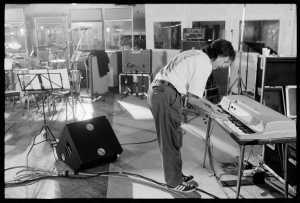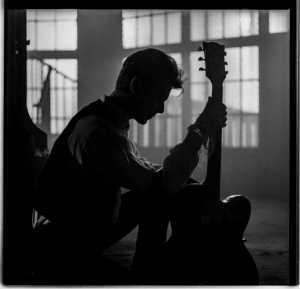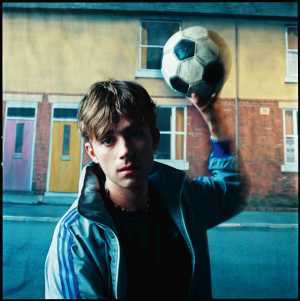Since the early 1980s, the London-born photographer Lawrence Watson has combined his love of music with a career capturing the biggest stars of the music world. At the behest of his father, Watson left school aged 16, after being told, “You’re gonna get a job.” He initially served an apprenticeship in a darkroom in Old Street and then moved on to the darkroom at the now defunct regional ITV franchise London Weekend Television (LWT).
Watson managed to mix his job at LWT with personal work and, with access to a darkroom, he could print up his projects in between churning out hundreds of publicity prints for “cheesy” 1980s TV shows, like Game For a Laugh and Upstairs Downstairs. Arguably his ‘big break’ was through getting a concert shot of Southern Death Cult (who would later become The Cult) into the New Musical Express (NME).
The NME began commissioning him and, before he knew it, Watson was on an aeroplane bound for the US to document the rising stars of hip hop, including Run DMC, Public Enemy, Eric B and Rakim. Since that 1980s work, he has spent over 40 years shooting portraits of musicians, album covers, gigs and creative projects. This has included collaborations with many of Britain’s most iconic rock and pop stars, such as David Bowie, Paul McCartney, Oasis, The Smiths, New Order and Paul Weller.
Lawrence Watson’s latest project was borne out of tragedy – the death of his son Travis, who had been battling mental health issues. Thus, he has produced a number of limited-edition posters and prints of his striking music portraits, including previously unseen images of Bowie, Noel Gallagher and Pulp.
From this month, these are now being sold through the website Print Matters, with a percentage of the sales going to the charity Rethink Mental Illness. To discover more, square mile spoke to Lawrence Watson about his career, motivations and charity print collection.

Lawrence Watson
Square Mile: Talk us through how you got your first picture in NME?
Lawrence Watson: My stepbrother, Dave Dorrell, was starting to do reviews and pieces for them – he was pretty good, but my first submissions to NME weren’t.
Finally, after four or five attempts, they printed [a photograph of] the band Southern Death Cult at The Greyhound, in Hammersmith. It was a picture of Buzz, the guitarist, and that began my career with the NME. You used to get paid by the size they used pictures. You got nothing to cover your expenses.
SM: When was this?
LW: It was 1983. I was still working in darkrooms. I’d got a break working in the darkroom at London Weekend Television. That was great – they’d supply me with film and paper. I’d print my NME sessions in my lunch hour and do the gigs in the evenings or at the end of the day.
I started doing features for NME. I was getting nice jobs, using up my holiday at LWT, till it got to a point when I was getting enough work outside that the guy at LWT said, “Look, Lawrence, you’re getting more work outside doing that than here.” I didn’t want to spend the rest of my life in the darkroom and left LWT. You start to build up relationships with record labels and go on and do sleeve work or press pictures.
SM: Who was the first main British artist you worked with?
LW: Paul Weller. There was a lady called Shane Chapman, who worked in the press office at LWT and later became the wife of Mick Talbot of The Style Council. She’d seen me pogoing in the darkroom to The Jam, The Clash and my old reggae stuff. She said to me, “Mick [Talbot] and Paul [Weller] are doing a recording at Pinewood, a couple of numbers. Do you want me to see if you can come along and take some pictures?”
I went along with one little camera and one lens and then spent the whole weekend hand printing loads of lovely bromide prints. Then I took the box along to Solid Bond, Paul Weller’s old office in Marble Arch. He looked through them and suddenly picked up three prints and scribbled on the bottom ‘front cover, back cover, inside’.
I walked out of Solid Bond with the cover of the Style Council album. I went home on a cloud. From that day on I’ve worked with Paul on and off – from Wildwood to Stanley Road and various other record sleeves. I count him as a very good friend, so I’ve been very fortunate.
Paul Weller for London Evening Standard ES magazine cover, Henley, 1998
Lawrence Watson
SM: What album cover was that for?
LW: That was Confessions of a Pop Group, Paul’s last album with Polydor.
SM: Do you have a favourite artist you’ve collaborated with?
LW: I’ve also been fortunate with the relationship with Noel [Gallagher] and Oasis. I’ve always had a very good working relationship with Noel’s solo stuff, but I’ve had a great relationship with Paul [Weller] and I’m glad it still continues.
SM: Tell us a bit more the Oasis work.
LW: It was through Simon Halfon, the designer who designed Paul Weller’s record sleeves as well as the Oasis sleeves. A photographer had let them down at the last minute and it was a couple of days before Christmas. It was for their sixth album, Don’t Believe the Truth. Noel Gallagher had an idea to have this graffiti on garage doors so they’d booked. it. I don’t know who had let them down, but I was more than happy to shoot it.
I shot it in various ways – large format, panoramic cameras, fisheyes – just to give them lots of choice on the ways it could be photographed. I did some lovely, big blow-ups and it was a shot I did on a fisheye lens that Noel liked. He said, “It looks like a snow globe,” and they went for the black and white, very contrasty, lith print. Then, Emma at the Oasis office said, “The boys are really happy with what you’ve done for the sleeve. Do you fancy doing some press pictures for them?” That began the relationship with the Oasis brothers.
Liam Gallagher on Vespa GS, Brighton, 2009
Lawrence Watson
Liam Gallagher in a café, Brighton, 2009
Lawrence Watson
SM: There was a famous shoot in Brighton with Liam Gallagher?
LW: I did that to help Liam out with his Pretty Green menswear brand, because he didn’t know any fashion photographers and he wanted somebody he was comfortable with.
I knew the Quadrophenia references, so they said, “Can you come down? We’re gonna shoot some pictures in Brighton with the old scooters and then come back to London to do the shots with the big Union Jack flag?”
The flag shot became quite an iconic picture. Somebody sourced the flags and they found a lovely old vintage one – a giant one, which worked really well.
SM: What about shooting New Order?
LW: I did a couple of a sessions with them – an NME cover and a piece for inside the mag. I’d lugged all the gear up from the train from London – there was no budget for assistants. I was setting the lights up and [New Order singer] Bernard [Sumner] kept timing me during the bloody session and saying, “He’s got 15 minutes.”
He could see I was nervous. I was an old Joy Division fan, so I was intimidated enough by them. It was in their old rehearsal space in Macclesfield, but you get artists on bad days. We got the pictures, but it wasn’t quite what I wanted to do. Sometimes that happens. It was funny to be timed and have the artist keep looking at his watch.

Paul McCartney recording for War Child 'Help' charity album, Abbey Road Studios, London, 1995
Lawrence Watson
SM: You also did a bit of work with Paul McCartney?
LW: That’s when Andy McDonald and the GoDiscs mob organised the War Child album. All the artists were in studios around London on one day. I don’t know how they did it – it was recorded, mixed, pressed and put out within about five days.
John Squire (of the Stone Roses) did the cover. I’d gone down to do Paul, but it was turning into this mega amount of people coming down. People just kept coming through – Kate Moss, Johnny Depp… obviously this was the place to be that day. Paul McCartney did keyboards on a track (a new version of The Beatles’ Come Together); Noel [Gallagher] was there as were Ocean Colour Scene. It’s the 30th anniversary this year, so it would be nice to bring it all back out – lots of the photographs have never been seen before.
SM: When did you work with Bowie?
LW: It was on a video shoot with the guitarist Adrian Belew – the one Bowie pinched from Frank Zappa – up in Edinburgh. The song was Pretty Pink Rose and Bowie was helping him out. It was the early days of MTV and if Bowie featured in the video it would get a lot more plays.
Bowie was charming and I rattled off a roll of film shot in a darkened corner. It was just before lunch and I said, ‘Look. That set-up is really lovely, David. Can I rattle off a roll on the Hasselblad?’ He said, ‘Of course, Lawrence, that’s no problem.’
I got to spend my day with Bowie; he was charming – a lovely man. He respected the image, so he wanted to get that partnership. As a photographer, it becomes sort of an alliance – you’re both striving to get something strong and a great image, so we worked together.

David Bowie in silhouette at Adrian Belew video shoot, Edinburgh, 1990
Lawrence Watson
SM: You must come into a shoot with your own ideas and concepts for how it’s going to look. How do you collaborate with musicians from that standpoint?
LW: For record sleeves and things like that, we would have had meetings and discussed references for locations, done some research and recced places. If it’s a studio [shoot] idea with a big, high-profile band, you’ll maybe have done some tests and things.
With people like Paul [Weller] and Noel [Gallagher] they’ll have some ideas they’d like to go with, then you try to add to those and just enrich the idea. Sometimes you’re left to your own devices or something good comes out of a press session that they really like.
SM: Why did you get involved with the Rethink Mental Illness charity?
LW: My son suffered from mental health. I wish we could change the words ‘mental health’ to something like ‘mindful health’. Youngsters and all sorts of people suffer from it; it is mindful of thoughts that they just can’t stop things pinging round their heads, and Travis did suffer with that. I wanted to do something at the time and had these grand plans, but my world turned upside down and I just went into grief [after Travis’s death].
Then Dave Hill, who has got a lovely gallery (the David Hill Gallery) down on Ladbroke Grove, had heard that I wanted to do something and said, “Look, we’re thinking of doing something called Print Matters.” It was just finding a charity that gives something back and helps youngsters – 15- to 25-year-old men is the highest suicide rate. The statistics are scary for young men. It happens to women as well, but it seems to be stacked towards young men who don’t get through that period [of life]. It came about through trying to put something back through my work.

Damon Albarn at Holborn Studios for Rockin’ On magazine, London, 1995
Lawrence Watson
SM: Who runs Print Matters?
LW: Dave Hill. It’s got a body of my work and there’s a couple of other photographers involved – there’s a guy, Peter Angelo Simon, who did all the [Muhammad] Ali pictures. Dave was trying to get a few other photographers as well, so it wasn’t just a music thing. I’d stressed that I wanted to do something for mental health, and Dave did a lot of the research on finding a charity that we could work with. We found one that understood what we were doing and were really up for it.
SM: Was choosing the images to feature in the Print Matters collection tricky?
LW: Not too bad. Dave, with his experience of running a gallery, helped and we tried to revisit some of the contact sheets and find some new images – some of the Bowie shots, some of the Madness ones, some Pogues stuff that hadn’t been seen before. It was good for me to revisit those.
There’s plenty more to dig out. I think the edit will be ongoing, because it was only a few months ago that we started organising the whole thing… So we’ve done it quite quickly.
SM: What can people buy?
LW: We’ve done a nice thing with affordable posters. The Liam Gallagher Union Jack shots are up there for a reasonable £85, and we’re getting a nice, big-sized poster on good, heavy-weight paper. Then we have some great 20x16-inch bromides and C-types for both the black and white and colour images in limited-edition runs of 25.
SM: Are the posters and prints all personally signed by you?
LW: We stated ‘signed’ for the posters, so I’ve got to sign 500 of those, as well.
To buy any of Lawrence Watson’s limited-edition prints and posters visit printmatters.uk. See more at: lawrencewatsonphotography.com
